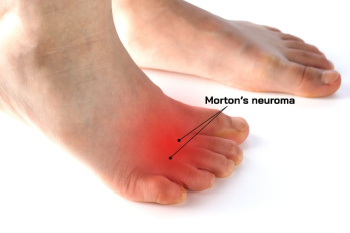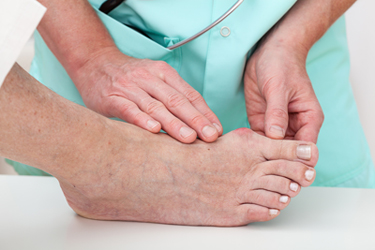Connect With Us
Blog
Items filtered by date: October 2024
See Your Foot Specialist Regularly If You Work On Your Feet
Foot Pain While Cycling

Foot pain during cycling is a common issue that can arise from several factors, significantly impacting performance and comfort. One primary reason is wearing improper cycling shoes. Shoes that do not fit well can lead to pressure points and discomfort, making it essential to choose footwear that provides adequate support and a snug fit. Another critical factor is the location of the cleats. Misaligned cleats can cause improper foot positioning, resulting in pain and strain on the feet during pedaling. Ensuring that cleats are positioned correctly can promote a more natural pedal stroke and distribute pressure evenly across the foot. Additionally, consider adjusting the pedal tension and maintaining proper bike fit to enhance comfort. Having foot pain while cycling can cause temporary time off from pursuing this hobby. If this applies to you, it is suggested that you consult a podiatrist who can offer you effective relief and treatment solutions.
Ankle and foot injuries are common among athletes and in many sports. They can be caused by several problems and may be potentially serious. If you are feeling pain or think you were injured in a sporting event or when exercising, consult with Warren Levy, DPM from Armitage Podiatry Center. Our doctor will assess your condition and provide you with quality foot and ankle treatment.
Common Injuries
The most common injuries that occur in sporting activities include:
- Achilles Tendonitis
- Achilles Tendon Rupture
- Ankle Sprains
- Broken Foot
- Plantar Fasciitis
- Stress Fractures
- Turf Toe
Symptoms
Symptoms vary depending upon the injury and in some cases, there may be no symptoms at all. However, in most cases, some form of symptom is experienced. Pain, aching, burning, bruising, tenderness, tightness or stiffness, sensation loss, difficulty moving, and swelling are the most common symptoms.
Treatment
Just as symptoms vary depending upon the injury, so do treatment options. A common treatment method is known as the RICE method. This method involves rest, applying ice, compression and elevating the afflicted foot or ankle. If the injury appears to be more serious, surgery might be required, such as arthroscopic or reconstructive surgery. Lastly, rehabilitation or therapy might be needed to gain full functionality in the afflicted area. Any discomfort experienced by an athlete must be evaluated by a licensed, reputable medical professional.
If you have any questions, please feel free to contact our office located in Chicago, IL . We offer the newest diagnostic and treatment technologies for all your foot care needs.
Types of Congenital Foot Conditions

Congenital foot conditions encompass a range of abnormalities that affect foot structure and function from birth. One common condition is metatarsus adductus, where the front part of the foot curves inward, often resolving on its own but sometimes requiring intervention. Clubfoot is another prevalent condition characterized by a twisted appearance, causing the foot to point downward and inward. This condition typically necessitates early treatment to prevent mobility issues. Calcaneovalgus involves an upward flexion of the foot at the ankle and can lead to a flat appearance, often improving with conservative management. Additionally, congenital vertical talus presents a more complex challenge, with the foot positioned in a rigid, flat state that may require surgical intervention for correction. If your child has been born with one of these conditions, it is suggested that a podiatrist is promptly consulted so the appropriate treatment can begin.
Congenital foot problems require immediate attention to avoid future complications. If you have any concerns, contact Warren Levy, DPM of Armitage Podiatry Center. Our doctor can provide the care you need to keep you pain-free and on your feet.
Congenital foot problems are deformities affecting the feet, toes, and/or ankles that children are born with. Some of these conditions have a genetic cause while others just happen. Some specific foot ailments that children may be born with include clubfeet, polydactyly/macrodactyly, and cleft foot. There are several other foot anomalies that can occur congenitally. What all of these conditions have in common is that a child may experience difficulty walking or performing everyday activities, as well as trouble finding footwear that fits their foot deformity. Some of these conditions are more serious than others. Consulting with a podiatrist as early as possible will help in properly diagnosing a child’s foot condition while getting the necessary treatment underway.
What are Causes of Congenital Foot Problem?
A congenital foot problem is one that happens to a child at birth. These conditions can be caused by a genetic predisposition, developmental or positional abnormalities during gestation, or with no known cause.
What are Symptoms of Congenital Foot Problems?
Symptoms vary by the congenital condition. Symptoms may consist of the following:
- Clubfoot, where tendons are shortened, bones are shaped differently, and the Achilles tendon is tight, causing the foot to point in and down. It is also possible for the soles of the feet to face each other.
- Polydactyly, which usually consists of a nubbin or small lump of tissue without a bone, a toe that is partially formed but has no joints, or an extra toe.
- Vertical talus, where the talus bone forms in the wrong position causing other bones in the foot to line up improperly, the front of the foot to point up, and the bottom of the foot to stiffen, with no arch, and to curve out.
- Tarsal coalition, when there is an abnormal connection of two or more bones in the foot leading to severe, rigid flatfoot.
- Cleft foot, where there are missing toes, a V-shaped cleft, and other anatomical differences.
- Macrodactyly, when the toes are abnormally large due to overgrowth of the underlying bone or soft tissue.
Treatment and Prevention
While there is nothing one can do to prevent congenital foot problems, raising awareness and receiving neonatal screenings are important. Early detection by taking your child to a podiatrist leads to the best outcome possible.
If you have any questions please feel free to contact our office located in Chicago, IL . We offer the newest diagnostic tools and technology to treat your foot and ankle needs.
Facts About Morton’s Neuroma

Morton's neuroma involves the thickening of a nerve in the foot, most often found between the third and fourth toes. It results from persistent pressure and irritation, which can lead to pain, numbness, or tingling in the toes and the ball of the foot. Symptoms of Morton’s neuroma include a burning sensation or the feeling of a small lump under the foot. Women are more commonly affected, likely due to wearing narrow, high-heeled shoes that force the bones of the feet into unnatural positions. Being overweight can also increase the risk. A podiatrist can diagnose Morton's neuroma by examining the foot and evaluating the pain’s location and severity. They can offer such treatment solutions as custom orthotics, changes in footwear, or in some cases, injections to reduce inflammation. If conservative approaches are not effective, surgery may be considered. If you have symptoms that may indicate Morton's neuroma, it is suggested that you schedule an appointment with a podiatrist.
Morton’s neuroma is a very uncomfortable condition to live with. If you think you have Morton’s neuroma, contact Warren Levy, DPM of Armitage Podiatry Center. Our doctor will attend to all of your foot care needs and answer any of your related questions.
Morton’s Neuroma
Morton's neuroma is a painful foot condition that commonly affects the areas between the second and third or third and fourth toe, although other areas of the foot are also susceptible. Morton’s neuroma is caused by an inflamed nerve in the foot that is being squeezed and aggravated by surrounding bones.
What Increases the Chances of Having Morton’s Neuroma?
- Ill-fitting high heels or shoes that add pressure to the toe or foot
- Jogging, running or any sport that involves constant impact to the foot
- Flat feet, bunions, and any other foot deformities
Morton’s neuroma is a very treatable condition. Orthotics and shoe inserts can often be used to alleviate the pain on the forefront of the feet. In more severe cases, corticosteroids can also be prescribed. In order to figure out the best treatment for your neuroma, it’s recommended to seek the care of a podiatrist who can diagnose your condition and provide different treatment options.
If you have any questions, please feel free to contact our office located in Chicago, IL . We offer the newest diagnostic and treatment technologies for all your foot care needs.
Recognizing Signs of Gout in the Feet

Gout is a form of arthritis that can cause significant discomfort, particularly in the feet. One of the most common signs is intense pain, often occurring suddenly and affecting the big toe, although it can impact other joints as well. Inflammation is another key indicator, with the affected area becoming swollen and tender to the touch. Additionally, skin discoloration may occur, with the skin appearing red or purplish around the joint. Some individuals may also experience itchy, peeling skin, which can add further discomfort. If you have pain in your big toe, it may be gout and may lead to one or more gout attacks. If this applies to you, it is strongly suggested that you are under the care of a podiatrist who can accurately diagnose gout and offer you relief and management tips.
Gout is a foot condition that requires certain treatment and care. If you are seeking treatment, contact Warren Levy, DPM from Armitage Podiatry Center. Our doctor will treat your foot and ankle needs.
What Is Gout?
Gout is a type of arthritis caused by a buildup of uric acid in the bloodstream. It often develops in the foot, especially the big toe area, although it can manifest in other parts of the body as well. Gout can make walking and standing very painful and is especially common in diabetics and the obese.
People typically get gout because of a poor diet. Genetic predisposition is also a factor. The children of parents who have had gout frequently have a chance of developing it themselves.
Gout can easily be identified by redness and inflammation of the big toe and the surrounding areas of the foot. Other symptoms include extreme fatigue, joint pain, and running high fevers. Sometimes corticosteroid drugs can be prescribed to treat gout, but the best way to combat this disease is to get more exercise and eat a better diet.
If you have any questions please feel free to contact our office located in Chicago, IL . We offer the newest diagnostic and treatment technologies for all your foot and ankle needs.
How to Manage Bunions

A bunion is a bony bump that forms at the base of the big toe, where it meets the long bone of the foot. Bunions develop when the big toe pushes towards the second toe, causing the joint at the base of the big toe to protrude. This misalignment is often made worse by wearing tight or ill-fitting shoes, particularly those with high heels or a narrow toe box. Symptoms of bunions include pain, swelling, and redness surrounding the affected joint, and difficulty finding comfortable footwear. Over time, the misalignment can worsen, making daily activities uncomfortable. Treatment for bunions focuses on alleviating pain and preventing further progression. A podiatrist can discuss options that may include wearing wider, more supportive shoes, using orthotic devices to correct foot alignment, and performing exercises to improve joint mobility. In persistent cases, surgery may be considered. If you have developed a bunion, it is suggested you schedule an appointment with a podiatrist for a treatment plan.
If you are suffering from bunions, contact Warren Levy, DPM of Armitage Podiatry Center. Our doctor can provide the care you need to keep you pain-free and on your feet.
What Is a Bunion?
A bunion is formed of swollen tissue or an enlargement of boney growth, usually located at the base joint of the toe that connects to the foot. The swelling occurs due to the bones in the big toe shifting inward, which impacts the other toes of the foot. This causes the area around the base of the big toe to become inflamed and painful.
Why Do Bunions Form?
Genetics – Susceptibility to bunions are often hereditary
Stress on the feet – Poorly fitted and uncomfortable footwear that places stress on feet, such as heels, can worsen existing bunions
How Are Bunions Diagnosed?
Doctors often perform two tests – blood tests and x-rays – when trying to diagnose bunions, especially in the early stages of development. Blood tests help determine if the foot pain is being caused by something else, such as arthritis, while x-rays provide a clear picture of your bone structure to your doctor.
How Are Bunions Treated?
- Refrain from wearing heels or similar shoes that cause discomfort
- Select wider shoes that can provide more comfort and reduce pain
- Anti-inflammatory and pain management drugs
- Orthotics or foot inserts
- Surgery
If you have any questions, please feel free to contact our office located in Chicago, IL . We offer the newest diagnostic and treatment technologies for all your foot care needs.

